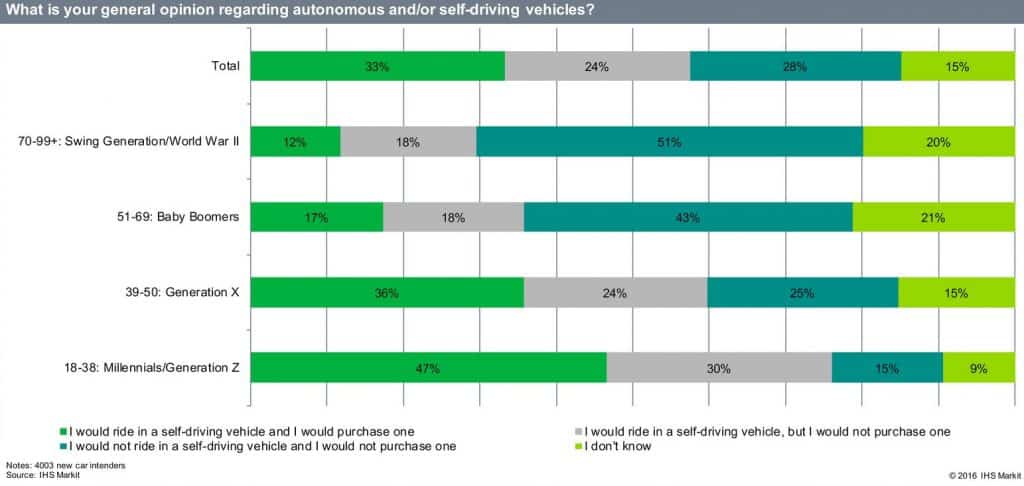 IHS has some interesting predictions about connected cars, self-driving cars and advanced safety features including how they will be paid for, who wants them and what is expected.
IHS has some interesting predictions about connected cars, self-driving cars and advanced safety features including how they will be paid for, who wants them and what is expected.
IHS Automotive forecasts, 55% of annual global new vehicle sales in 2020 will be vehicles that are connected. IHS defines connected cars as include those with a combination of the following technologies: advanced driver assistance systems (ADAS), smartphone integration, telematics, infotainment, remote vehicle controls, Wi-Fi, and autonomy.
Nearly one third of survey respondents in all age categories indicated they would ride in a self-driving vehicle and purchase one. An additional 25 percent suggested that while they would indeed ride in one, they would not purchase one.
However, millennials are excited about autonomy – when analyzing responses from millennials, more than half are ready to be driven in one and would purchase one; while nearly 75 percent are comfortable with artificial intelligence driving the vehicle.
IHS Automotive forecasts indicate 21 million vehicles with some form of autonomy will be sold in 2035 – and with substantial growth between now and then, it’s possible millennials could make up a large share of the initial customer base for these advanced vehicles.
Safety Should Come Free
While ADAS systems are most desirable among global survey respondents, consumers do not want to pay for these advancements. Traditionally packaged within vehicles as part of optional features like leather seats and high-end infotainment systems, consumers expect advanced safety systems to be included in new vehicles at no charge – since electronic stability control systems and pre-charged brakes have become standard equipment on a global scale.
However, of the global audience, U.S. consumers are most willing to pay for ADAS features, indicating they would be willing to spend between $427 and $505 at the time of vehicle purchase, depending on the feature. This is in line with current market prices. Consumers in other regions are less willing to pay market prices for these technologies in their next vehicle.
Have Software Update Will Pay
74 percent of consumers who currently own a vehicle with an infotainment system are willing to pay for software updates that improve or add functionality to their vehicle, and the response was universally global. In the US, 89 percent of millennials surveyed indicated they would pay for a software update – and more than 90 percent of millennials in China agreed they would be willing to pay.
Smartphones Navigate the Way
When using smartphones in vehicles, the most often used apps by consumers while in their vehicle were those intended for navigation, as indicated by 52 percent of respondents globally. Apps for weather were second, with 41 percent of respondents, and 37 percent of consumers reported using both music and news apps while in their vehicles.
Not surprisingly, these features are the most popular for embedded displays in audio and navigation systems. Interestingly, podcasting apps registered very low among the audience surveyed, despite a recent resurgence in popularity.
Navigation apps are particularly popular in China with 56 percent of respondents using this, compared to respondents in Germany (55 percent) and in the US (54 percent). In China, the breakneck construction of new roads and highways likely makes drivers more dependent on navigation apps. China also diverged from the other regional respondents by being more likely to use music apps (43 percent), social networking (37 percent) and driver’s aids (30 percent) in the car when compared to average.
However, communications apps are much more popular in Germany (33 percent), China (24 percent) and the UK (20 percent) when compared to the US (14 percent).
More than 4,000 vehicle owners intending to purchase a new vehicle within the next 36 months were surveyed, representing four key automotive markets – the U.S., China, Germany and the United Kingdom. This is the fourth annual survey of its kind from IHS Automotive, part of IHS Markit (Nasdaq: INFO), a world leader in critical information, analytics and solutions.
IHS insights is usually on the mark but on this one I believe 55% by 2020 is an underestimate. Considering there will be over a quarter of a million connected commercial trucks by this time or earlier, I believe the % of connected passenger vehicles could exceed 75%. I also think the overall number of passenger cars on the road may be lower due to millennials telecommuting, sharing rides, using transit and living closer to cities and work.